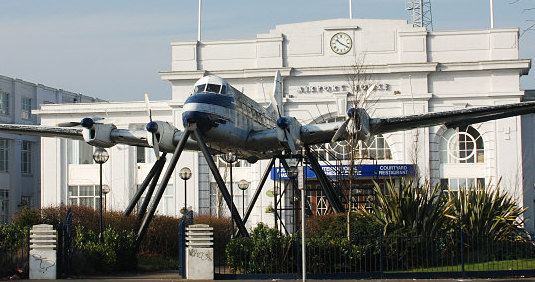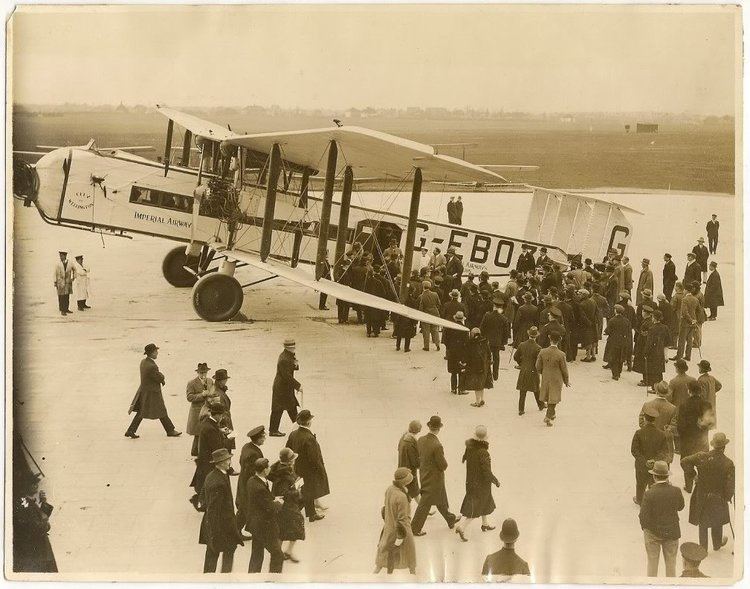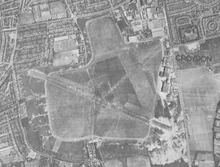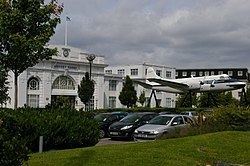Airport type defunct 3,900 1,200 | Serves London, UK NW/SE 3,900 | |
 | ||
Website www.croydonairport.org.uk | ||
Croydon airport in the 1930s
Croydon Airport (ICAO: EGCR) was an airport in South London straddling the boundary between what are now the London boroughs of Croydon and Sutton. It was the main airport for London before it was replaced by Northolt Aerodrome, London Heathrow Airport and Gatwick Airport. The terminal building and entrance lodge are Grade II listed buildings.
Contents
- Croydon airport in the 1930s
- Croydon airport 1938
- Origin
- Expansion
- Battle of Britain
- Postwar developments and final closure
- The area today
- The buildings
- Aviators pioneers and aircraft
- Accidents and incidents
- References

Croydon airport 1938
Origin

In 1915 Beddington Aerodrome was established – one of a number of small airfields around London that were created for protection against Zeppelin raids during the First World War. In 1916 a wooden air traffic control and Customs building was built on one of these two aerodromes. Waddon Aerodrome opened in 1918, adjoining National Aircraft Factory No. 1, to serve aircraft test flights. The two airfields were on each side of Plough Lane (the lane running north from Russell Hill near Purley, in the accompanying old map).

The two aerodromes were combined following the end of the First World War to become Croydon Aerodrome, the gateway for all international flights to and from London. The new aerodrome opened on 29 March 1920. Plough Lane remained a public road crossing the site, and road traffic was halted when necessary, first by a man with a red flag and later by a gate. The aerodrome stimulated a growth in regular scheduled flights carrying passengers, mail and freight, the first destinations being Paris, Amsterdam and Rotterdam. Two flights daily from Paris were scheduled for ease of communication with London during the Paris Peace Conference.

Penshurst Airfield was an alternative destination for airliners when Croydon was closed due to fog. One such diversion was on 24 September 1921, when a de Havilland DH.18 aircraft was diverted to Penshurst. This situation lasted until Penshurst closed on 28 July 1936.
Croydon was the first airport in the world to introduce air traffic control.

In 1923 flights to Berlin Tempelhof Airport began, and the airport became the operating base for Imperial Airways, remembered in the road name Imperial Way on the site today.
Following the Imperial Airways de Havilland DH.34 crash of December 1924, conditions at Croydon were criticised by the subsequent public inquiry.
Expansion
The airport expanded during the 1920s, with a new complex of buildings built adjoining Purley Way, including the first purpose-designed air terminal in the UK, the Aerodrome Hotel, and extensive hangars. The development cost £267,000 (£14.5 million in today's prices) . Plough Lane was closed permanently to let heavier airliners land and depart safely. The airport's terminal building and control tower were completed in 1928; the old wooden air traffic control and Customs building was demolished. The new buildings and layout began operations on 20 January 1928, and were officially opened on 2 May.
Croydon was where regular international passenger services began, initially using converted wartime bombers, and the Croydon-Le Bourget route soon became the busiest in the world. Air Traffic Control was first developed here, as was the distress call ‘Mayday Mayday Mayday’. Amy Johnson took off from Croydon for her record-breaking flight to Australia. Charles Lindbergh arrived in Spirit of St. Louis, to be greeted by an enthusiastic crowd. Winston Churchill also took flying lessons.
On the morning of 11 July 1936 Major Hugh Pollard, and Cecil Bebb left Croydon Airport for the Canary Islands in a de Havilland Dragon Rapide aircraft, where they picked up General Francisco Franco, taking him to Spanish Morocco and thereby helping to trigger the outbreak of the Spanish Civil War.
Imperial Airways used the Handley Page HP42/HP45 four-engined biplanes from Croydon, and the Armstrong Whitworth Atlanta, which was the first monoplane airliner used by the airline, intended for use on the African routes. In March 1937 British Airways Ltd operated from Croydon, moving to Heston Aerodrome in May 1938. Imperial Airways, serving routes in the British Empire, and British Airways Ltd, serving European routes, were merged by the Chamberlain government in November 1938 to become British Overseas Airways Corporation (BOAC). Larger four-engined monoplanes, Armstrong Whitworth Ensign series (G-ADSR) came into service that year.
The airport also hosted a much-publicised visit by Gertrud Scholtz-Klink, leader of the National Socialist Women’s League (NS-Frauenschaft) and rumoured to be a spy; historians have speculated that she landed in Britain to cultivate Germans spies living here, in the run-up to WWII.
When the Second World War started in September 1939, Croydon Airport was closed to civil aviation but played a vital role as a fighter station during the Battle of Britain. No. 92 Squadron flew Supermarine Spitfires from RAF Croydon during the early part of the Second World War and the Battle of Britain.
Battle of Britain
On 15 August 1940 Croydon Airport was attacked in the first major air raid on the London area. At around 6.20 pm 22 Bf 110 and Bf 109 fighter-bombers of Erpr.Gr.210 mounted a final raid of the day, intended for RAF Kenley nearby, but attacked Croydon (four miles further north) in error. The armoury was destroyed, the civilian airport terminal building was badly damaged, and a hangar was damaged by cannon fire and blast. Another hangar and about forty training aircraft in it went up in flames. Six airfield personnel died (four airmen from No. 111 Squadron, an Officer of 1 (RCAF), and a female telephonist from Station HQ). Factories next to Croydon Airport took the worst of the bombing. The British NSF factory (making electrical components) was almost entirely destroyed, and the Bourjois perfume factory gutted. The Rollason Aircraft factory also received bomb hits and accounted for many of the 62 civilians (including five women) killed and 192 injured. Of the raiders, eight aircraft were downed by the Hurricanes of 32 and 111 Squadrons.
Croydon became the base of RAF Transport Command in 1944.
Postwar developments and final closure
Following the end of the war it was realised that postwar airliners and cargo aircraft would be larger and air traffic would intensify. Urban spread of south London, and surrounding villages growing into towns, had enclosed Croydon Airport and left it no room for expansion. Heathrow was therefore designated as London's airport.
Croydon returned to civil control in February 1946; a diagram in the issue of Flight dated 11 April shows 1,250 yards (1,140 m) ground run in the 170–350 direction, 1,150 yards (1,050 m) 060-240 and 1,100 yards (1,000 m) 120–300 (the numbers are degrees clockwise from north). Northolt opened to the airlines soon after that, cutting Croydon's traffic, but the September 1946 ABC Guide shows 218 departures a week to Belfast, Dublin, Liverpool, Manchester, Glasgow (Renfrew), Jersey, Guernsey, and several continental airports. A year later there were 56 departures a week, mostly BEA de Havilland Dragon Rapides that weeks later left Croydon for good.
It was decided in 1952 that the airport would eventually be closed, as Blackbushe Airport in Hampshire and Northolt Aerodrome in Middlesex could accommodate European flights during the 1950s. The last scheduled flight from Croydon departed at 6:15pm on 30 September 1959, followed by the last aircraft (a private flight), at 7:45pm; the airfield officially closed at 10:20pm.
On 27 September 2009, to mark the 50th anniversary of the closing of the airport, eleven light aircraft, including eight biplanes, staged a flypast. A gold laurel leaf tribute was laid in the control tower to mark the anniversary.
The area today
Much of the site has been built over, but some of the terminal buildings near Purley Way (the A23 road) are still visible, clearly identifiable as to their former purpose. The former terminal building is called Airport House, and the former control tower houses a visitors' centre.
A de Havilland Heron (a small propeller-driven British airliner of the 1950s), is displayed outside Airport House on struts flanking the entry path (as of November 2009). The Heron is painted to represent an example registered G-AOXL of Morton Air Services, which was the aircraft that flew the last passenger flight from Croydon on 30 September 1959. A memorial to those lost in the Battle of Britain stands slightly to the south.
Although Croydon has long ceased operation, the two cut ends of Plough Lane have never been reunited, but the area between has been developed instead into parkland, playing fields, and the Roundshaw residential estate with its roads aptly named after aviators and aircraft. All that remains of the runways is a small area of tarmac about 400 feet (120 m) long each way in Roundshaw Park just west of Purley Way, which is a remnant of the WNW-ESE runway due south of the control buildings; it can be seen at 51.351067°N 0.117449°W / 51.351067; -0.117449; the "arm" may be a remnant of a taxiway to Hangar B. The area is used primarily by walkers, model aircraft enthusiasts, and locals playing football and baseball.
The church on the Roundshaw estate has a cross on its outside wall that was made from the cut down propeller of a Spitfire based at Croydon during the Second World War.
The area is still known as Croydon Airport for transport purposes and was the location for Croydon Water Palace.
In recognition of the historical significance of the aerodrome, two local schools (Waddon Infants School and Duppas Junior School) have merged and became The Aerodrome School from September 2010.
In films and TV programmes (e.g. Brass) Croydon Airport has occasionally been represented by Barton Airport, near Manchester, as is evident from its distinctive control tower.
The buildings
The Aerodrome Hotel and the terminal building including its grand booking hall were built in the neo-classical geometrical design typical of the early 20th Century. A further item that would have caught the eye of visitor and traveller alike was the time zone tower (now lost) in the booking hall with its dials depicting the times in different parts of the world. Croydon Airport's Aerodrome Hotel is part of Croydon Vision 2020 regeneration plan.
The Airport Hotel survives as the independent Hallmark Hotel.
Aviators, pioneers and aircraft
The aerodrome was known the world over, its fame being spread by the many aviators and pioneers who touched down at Croydon, such as:
